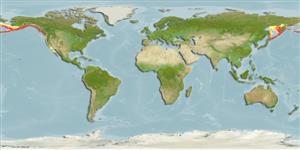Environment: milieu / climate zone / depth range / distribution range
Ecologia
marinhas batidemersal; intervalo de profundidade 0 - 825 m (Ref. 6793), usually 165 - 293 m (Ref. 27437). Deep-water; 64°N - 24°N, 143°E - 110°W (Ref. 54884)
North Pacific: Honshu, Japan to Cape Navarin in the Bering Sea (but not in the Sea of Okhotsk) and La Jolla, California, and along the Aleutians from Stalemate Bank and Bowers Bank to the Alaska Peninsula. Stocks have suffered severe population decline due to overfishing (Ref. 27437).
Comprimento de primeira maturação / Tamanho / Peso / Idade
Maturity: Lm 33.2, range 25 - 43.3 cm
Max length : 53.0 cm TL macho/indeterminado; (Ref. 56527); peso máx. publicado: 2.1 kg (Ref. 56527); idade máx. registrada: 103 anos (Ref. 93933)
Descrição suscinta
Chaves de identificação | Morfologia | Morfometria
Espinhos dorsais (total) : 13; Raios dorsais (total) : 14 - 17; Espinhos anais: 3; Raios anais : 6 - 9; Vértebras: 26. Head spines weak - nasal, preocular, supraocular (may be absent), postocular, tympanic, parietal, and nuchal (may be absent) spines present, coronal spine absent (Ref. 27437). Long lower jaw with prominent forward directed symphyseal knob (Ref. 27437). Posterior margin of caudal indented (Ref. 6885). Bright to light red, usually with dark markings dorsally, may have some dark stippling on sides and dark blotch on caudal peduncle (Ref. 27437).
Abundant in offshore waters (Ref. 2850). Young pelagic up to age 3 (Ref. 6885). Grows slowly (Ref. 2850). Viviparous (Ref. 34817). Very important commercial rockfish in the North Pacific (Ref. 2850, 27437). Marketed as fillets (Ref. 2850). Utilized fresh and frozen; eaten fried, microwaved and baked (Ref. 9988).
Produces young in small numbers, only about 300,000 when the fish is 20 years old.
Eschmeyer, W.N., E.S. Herald and H. Hammann, 1983. A field guide to Pacific coast fishes of North America. Boston (MA, USA): Houghton Mifflin Company. xii+336 p. (Ref. 2850)
Status na Lista Vermelha da UICN (Ref. 130435: Version 2024-1)
Ameaça para os humanos
Harmless
Uso pelos humanos
Pescarias: altamente comercial; peixe esportivo: sim
Ferramentas
Relatórios especiais
Baixar XML
Fontes da internet
Estimates based on models
Preferred temperature (Ref.
123201): 1.1 - 6.4, mean 3.8 °C (based on 124 cells).
Índice de diversidade filogenética (Ref.
82804): PD
50 = 0.5000 [Uniqueness, from 0.5 = low to 2.0 = high].
Bayesian length-weight: a=0.00933 (0.00775 - 0.01123), b=3.09 (3.05 - 3.13), in cm total length, based on LWR estimates for this species (Ref.
93245).
Nível Trófico (Ref.
69278): 3.5 ±0.3 se; based on diet studies.
Generation time: 8.3 (7.8 - 10.4) years. Estimated as median ln(3)/K based on 33
growth studies.
Resiliência (Ref.
120179): Muito baixo(a), tempo mínimo de duplicação da população maior que 14 anos (Musick et al. 2000 (Ref.
36717); tmax=103; tm=7; K=0.1; Fec=31,000).
Prior r = 0.20, 95% CL = 0.13 - 0.29, Based on 8 full stock assessments.
Fishing Vulnerability (Ref.
59153): High vulnerability (59 of 100).
Climate Vulnerability (Ref.
125649): Moderate vulnerability (38 of 100).
Nutrients (Ref.
124155): Calcium = 17.4 [6.4, 61.2] mg/100g; Iron = 0.305 [0.125, 0.808] mg/100g; Protein = 17.2 [16.0, 18.5] %; Omega3 = 0.7 [0.3, 1.8] g/100g; Selenium = 44.5 [15.6, 134.0] μg/100g; VitaminA = 16.3 [3.9, 72.7] μg/100g; Zinc = 0.3 [0.2, 0.6] mg/100g (wet weight);
